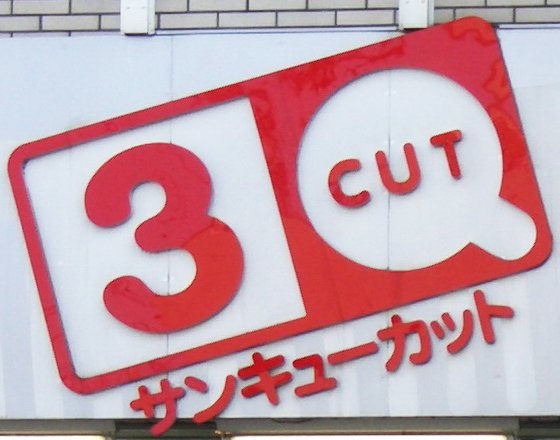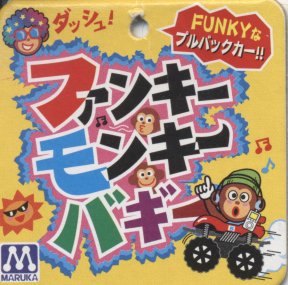
has been transformed into "3 (san) Q"
 |
| Barber's sign: English "thank you cut" has been transformed into "3 (san) Q" |
|---|
Japanese usually writes words borrowed from foreign languages in katakana. Katakana is phonetic, so a katakana transcription of an English word is based on how the word sounds, not how it is spelt. This page discusses ways to search for katakana versions of English words, and the rules for katakana transcription.
The first place to look for a Japanese version of an English word is a dictionary, to find the usual katakana equivalent. If the word is not in the dictionary, try to find a Japanese person to help you. Other tricks are explained in How can I find the Japanese name of a film, person, plant, etc.?
How a word appears as katakana depends on how the word is heard by native speakers. Japanese has fewer different sounds than English, and it does not have many ending consonants, so words tend to gain extra vowels. For example, the English word "cat" becomes katakana キャット (kyatto) with an extra "o" at the end, and "dog" becomes ドッグ (doggu) with an extra "u" at the end.
Vowels and diphthongs are usually changed into the nearest equivalent Japanese vowel. Japanese has fewer vowels than English, so the two different vowels in "fur" and "far" both get turned into Japanese ファー.
Plural words often become singular, thus "pajamas" becomes pajama (パジャマ), and "slippers" becomes suripaa (スリパー). Here the katakana パ used to represent the first vowel of "pajamas" is based on the spelling of the word.
Words with existing gairaigo forms usually keep that form. For example, "black coffee" becomes burakku kōhii (ブラックコーヒー), even though kōhii (コーヒー) for coffee originally comes from Dutch (see Which Japanese words come from Dutch?).
Japanese has tended to favour British pronunciations, with words like "vitamin", becoming a British-sounding bitamin (ビタミン) rather than American-sounding baitamin (バイタミン). The vowels used in Japanese are usually taken from the British pronunciation rather than the American.
The following table outlines the rules for transcribing English sounds. The English sounds are represented in International Phonetic Alphabet (IPA) form.
| English sound (IPA) | Japanese | Examples | Japanese transcription Capitals indicate small kana |
|---|---|---|---|
| Short vowels | |||
| ɪ | イ, i | pit | ピット (pitto) |
| ɛ | エ, e | pet | ペット (petto) |
| æ | ア, a | ham | ハム (hamu) |
| æ after k | キャ, kya | cap | キャップ (kyappu) |
| ʌ | ア, a | mug | マグ (magu) |
| ʌ spelt with an "o" | オ, o (sometimes) | monkey, front, London | モンキー, フロント, ロンドン (monkii, furonto, rondon) |
| ɒ | オ, o | socks | ソックス (sokkusu) |
| ʊ | ウ, u | book | ブック (bukku) |
| Schwa (weak vowel) | |||
| non-final ə | not fixed, based on spelling. | about, pilot, London | アバウト, パイロット, ロンドン (abauto, pairotto, rondon) |
| final position ə | aa | carrier, hamburger | キャリアー, ハンバーガー (kyariā, hambāgā) |
| Long vowels | |||
| ɑː | アー, ア aa, a | car | カー (kā) |
| iː | イー: ii | shield | シールド (shiirudo) |
| ɔː | オー: oo | horse | ホース (hōsu) |
| oa | オア: door | ドア (doa) | |
| ɜː | アー: aa | bird | バード (bādo) |
| uː | ウー ū | shoe | シュー (shū) |
| juː | ュウ yū, see What is yōon? | cube | キューブ (kyūbu) |
| Diphthongs | |||
| eɪ | エイ, ei | day | デイ (dei) |
| aɪ | アイ, ai | my | マイ (mai) |
| ɔɪ | オーイ, ōi | boy | ボーイ (bōi) |
| オイ, oi | toy | トイ (toi) | |
| əʊ | オ, o | phone | フォン (fon) |
| オー, ō | no | ノー (nō) | |
| aʊ | アウ, au | now | ナウ (nau) |
| ɪə | イア, ia | pierce | ピアス (piasu) |
| ɛə | エア, ea | hair | ヘア (hea) |
| ʊə | ウアー, uaa | tour | ツアー (tsuā) |
| Consonants | |||
| θ | シャ, シ, シュ, シェ, ショ s | think | シンク (shinku) |
| ð | z | the | ザ (za) |
| r | ラ, リ, ル, レ, ロ: r-kana | right | ライト (raito) |
| l | ラ, リ, ル, レ, ロ: r-kana | link | リンク (rinku) |
| ŋ spelt "ng" | ンガ, ンギ ng | singer | シンガー (shingā) |
| ン, n (occasionally) | Washington, surfing | ワシントン, サーフィン (washinton, sāfin) | |
| ŋ spelt "nk" or "nc" | n | sink | シンク (shinku) |
| v | b | love | ラブ (rabu) |
| ヴァ, ヴィ, ヴ, ヴェ, ヴォ: v, written as ヴ (the u katakana) plus a small vowel | visual | ヴィジュアル (vijuaru) | |
| Consonants taking small vowel kana | |||
| w | ウィ: u + small vowel kana | win | ウィン (win) |
| f | ファ, フィ, フ, フェ, フォ: hu + small vowel kana | fight | ファイト (faito) |
| Special consonant and vowel combinations | |||
| ti, di | ティ, ディ (te or de + small i) (newer method) | Disney | ディズニー (dizunii) |
| chi, ji (older method) | |||
| tu | トゥ: to + small u (newer method) | Tourette's syndrome | トゥレットシンドローム (turettoshindorōmu) |
| ツ: tsu | two | ツー (tsū) | |
| Consonant clusters | |||
| dz | ッズ zzu | goods, kids | グッズ, キッズ (guzzu, kizzu) |
 |
| Label from a children's toy "funky monkey buggy" |
|---|
Although most of the conversion from an English word into Japanese is based on the pronunciation, in several cases the pronunciation is based on spelling. In particular the schwa sound, the "uh" at the end of "doctor", has no near equivalent in Japanese and so is often transcribed depending on the spelling of the vowel. Other cases where spelling takes precedence include the ʌ vowel, the "u" in "cup" and "hut", which is usually a, but when spelt with an o becomes o. For example "monkey" is monkii rather than mankii. Japanese also lengthens n sounds, such as Anna (アンナ) for the English name Anna, when they are spelt with two ns.
In some cases, a mis-reading of a word survives into Japanese. For example, the woodworking tool "router", which should have become rautā, is known as a rūtā, based on the spelling.
Japanese tends to shorten three-mora constructions ending in syllabic n (ん) into two moras. For example "stainless steel" becomes sutenresu (ステンレス) rather than suteinresu (ステインレス).
In the case of people's names, Japanese tends to transcribe into near-equivalent versions not based on the pronunciation. For example, the English name Sarah is often transcribed into Sara (サラ) rather than Sērā (セーラー). For example American politician Sarah Palin is known as Sara Peirin (サラ・ペイリン) in Japan. Naomi is transcribed into Naomi (ナオミ), a common Japanese female name with a similar romanized spelling but different pronunciation, rather than Nēomi, a much closer representation of the pronunciation. For example British model Naomi Campbell is known as Naomi Kyamberu (ナオミ・キャンベル) in Japan. Similarly, Thomas is transcribed as Tōmasu using a long first vowel, and even more extremely, Paul may be transcribed into Paoro.
Copyright © 1994-2025 Ben Bullock
If you have questions, corrections, or comments, please contact Ben Bullock or use the discussion forum / Privacy policy

|

|

|

|

|
| Book reviews |
Convert Japanese numbers |
Handwritten kanji recognition |
Stroke order diagrams |
Convert Japanese units |